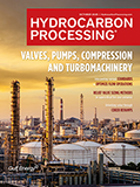Engineering & Design
HP Global: Outlook for UK chemical industry still optimistic
The recovery following the Great Recession has been long and hard for both the UK economy and its chemical industry. The chemical and pharmaceutical industry in the UK has not expanded on an annual ba..
HP Petrochemicals: Mexican executives see new government reforms spurring petrochemical activity
The CEO of Mexico’s state-run Pemex sees Mexico’s downstream and midstream industries offering big opportunities for new and foreign investments on the heels of the country’s massive energy reform program.
HP News
UAE FCC catalyst manufacturing facility completes Phase 1W. R. Grace & Co. and JV partner Al Dahra Agriculture Co. marked the commissioning of a new catalyst logistics silo terminal (pictured) and the..
HP Innovations
Air Liquide will build the world’s largest air separation unit (ASU) in Secunda, South Africa. An essential component of the 5,000-metric-ton-per-day ASU will be the AIRMAX compressor solution from MAN Diesel and Turbo, which will be the largest-dimension compressor constructed to date.
HP New Developments
Aspen Technology’s aspenONE Engineering and aspenONE Manufacturing and Supply Chain Version 8.8 software was developed for firms in the oil, gas, chemicals, engineering and construction, and other process industries.
Toyo picks Intergraph solutions to help construct new Malaysia cracker
When completed, RAPID will consist of a 300,000-bpd refinery and petrochemical complex with a combined capacity of producing 7.7 million tpy of various grades of products, including differentiated and specialty chemicals products such as synthetic rubbers and high-grade polymers.
Wison Engineering completes gas-based cracking furnace in Saudi Arabia
This project involved a new gas-based cracking furnace, extension of the pipe rack, a new decoking drum and its structure, a remote control room and an analysis house.
Jacobs wins work on Huntsman’s polyetheramine expansion in Singapore
The Jurong Island facility expansion is expected to enable backward integration to produce polyethers from locally-sourced feedstocks, according to Huntsman officials.
Abengoa to build new US waste-to-biofuels plant
Abengoa was selected to build the first US biorefinery using gasification technology to convert municipal solid waste (MSW) into syncrude that will be upgraded into jet fuel.
Consider new labyrinth seals to optimize compressor operations
Degradation of labyrinth seals in centrifugal impellers can have a significant impact on not only compressor power consumption but also on plant production rate. Upgrading to rub-tolerant seals can be..

- China's first coal-to-chemicals project with green hydrogen starts commercial operations 11/20
- Norsk e-Fuel and Braskem partner to turn captured carbon into long-lasting products 11/20
- Nigeria's Dangote refinery delays CDU maintenance to end of January 2026 11/20
- Technimont attends ground-breaking ceremony of Tengiz Gas separation Complex in Kazakhstan 11/20
- 42% of U.S. energy/critical infrastructure providers exposed to weaponized AI and email attacks 11/20
- EIA: U.S. crude stocks fall on higher demand, fuel inventories rise 11/20




